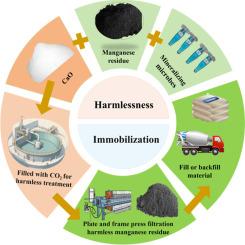锰矿化微生物、CaO和CO2联合作用下的锰渣无害化
IF 6.3
2区 环境科学与生态学
Q1 ENVIRONMENTAL SCIENCES
引用次数: 0
摘要
锰渣包括电解锰渣(EMR)和电解二氧化锰渣(EMDR),其成分复杂,容易产生重金属(HMs)和氨氮(NH4+-N)污染。本研究利用生石灰(CaO)、二氧化碳(CO2)和锰矿化微生物的联合修复系统稳定和固化锰渣中的HMs和NH4+-N。锰矿化微生物组合的测序显示,假单胞菌(Pseudomonas geniculata)、乳酸菌(Leclercia adecaarboxylata)、Ochrobactrum spp和tsuruhatdelftia构成了组合的大部分物种。此外,根据KEGG途径水平2分析,通过筛选和分离鉴定的锰矿化微生物表现出显著的金属抗性、金属吸收和金属解毒能力。各处理锰渣中NH4+-N水平均呈下降趋势,且矿化微生物处理组NH4+-N均低于国标(GB8979-1996)。实验结果表明,当锰矿化微生物浓度为1%,CO2流量为0.2 L/min,炭化时间为15 min时,无害锰渣的添加效果最大。根据XRD, SEM和EDS的结果,无害的锰渣表现出团聚,可以用作填充材料。在本研究中,锰矿化微生物、CaO和CO₂对锰渣中的HMs和NH₄⁺-N进行了处理,达到了一般工业固体废物标准,显示了大规模无害化处理的潜力。本文章由计算机程序翻译,如有差异,请以英文原文为准。

Manganese residue harmlessness with the combination of manganese mineralizing microbes, CaO and CO2
Manganese residue, including electrolytic manganese residue (EMR) and electrolytic manganese dioxide residue (EMDR), have complicated compositions and are easily generated heavy metals (HMs) and ammonia nitrogen (NH4+-N) pollution. In this study, HMs and NH4+-N in manganese residue were stabilized and solidified using a combined remediation system of quicklime (CaO), carbon dioxide (CO2), and manganese mineralizing microbes. The sequencing of the manganese mineralizing microbes assemblage revealed that Pseudomonas geniculata, Leclercia adecaarboxylata, Ochrobactrum spp., and Delftia tsuruhatensis comprised the majority of the assemblage species. Moreover, the manganese mineralizing microbes that were identified by screening and isolation exhibited significant metal resistance, metal absorption, and metal detoxifying abilities according to KEGG pathway level 2 analysis. The NH4+-N levels in the manganese residue across all treatments exhibited a downward trend, meanwhile NH4+-N in the manganese mineralizing microbes treatment groups were all lower than the GB standard (GB8979–1996). The findings of the experiment indicated that when manganese mineralizing microbes (1 % M), 0.2 L/min CO2 flow, and a carbonization time of >15 min were added, the greatest effect of the addition of the innocuous manganese residue was obtained. The innocuous manganese residue exhibited agglomeration and may be utilized as a filler material, according to the XRD, SEM, and EDS results. In this study, manganese mineralizing microbes, CaO and CO₂ treated HMs and NH₄⁺-N in manganese residue, achieving general industrial solid waste standards, demonstrating potential for large-scale harmless treatment.
求助全文
通过发布文献求助,成功后即可免费获取论文全文。
去求助
来源期刊

Journal of Environmental Sciences-china
环境科学-环境科学
CiteScore
13.70
自引率
0.00%
发文量
6354
审稿时长
2.6 months
期刊介绍:
The Journal of Environmental Sciences is an international journal started in 1989. The journal is devoted to publish original, peer-reviewed research papers on main aspects of environmental sciences, such as environmental chemistry, environmental biology, ecology, geosciences and environmental physics. Appropriate subjects include basic and applied research on atmospheric, terrestrial and aquatic environments, pollution control and abatement technology, conservation of natural resources, environmental health and toxicology. Announcements of international environmental science meetings and other recent information are also included.
 求助内容:
求助内容: 应助结果提醒方式:
应助结果提醒方式:


